Understanding Longitudinal Standing Waves in Musical Instruments and the Human Ear Canal
Musical instruments in the wind family rely on longitudinal standing waves to produce sound, with wind instruments like trumpet, flute, clarinet, and pipe organ being modified tubes of air. This article explores the concept of standing waves in open tubes of air and their relevance to instruments and human hearing, covering topics such as pipe organs, fundamental frequencies, and the auditory canal. Through visual representations and explanations, readers can grasp the physics behind sound production in these instruments and the human ear.
Download Presentation

Please find below an Image/Link to download the presentation.
The content on the website is provided AS IS for your information and personal use only. It may not be sold, licensed, or shared on other websites without obtaining consent from the author. Download presentation by click this link. If you encounter any issues during the download, it is possible that the publisher has removed the file from their server.
E N D
Presentation Transcript
Longitudinal Standing Waves Musical instruments in the wind family depend on longitudinal standing waves in producing sound. Since wind instruments (trumpet, flute, clarinet, pipe organ, etc.) are modified tubes or columns of air, it is useful to examine the standing waves that can be set up in such tubes.
Open tube of air A pictorial representation of longitudinal standing waves on a Slinky (left side) and in a tube of air (right side) that is open at both ends (A, antinode; N, node). https://www.youtube.com/watch?v=d7W2niNqHWg
Pipe Organ https://www.youtube.com/watch?v=uRqR9-akXEo The range of human hearing is roughly from twenty hertz to twenty kilohertz. Based on these limits and a value of 343 m/s for the speed of sound, what are the lengths of the longest and shortest pipes (open at both ends and producing sound at their fundamental frequencies) that you expect to find in a pipe organ?
Fundamental Frequency of the Human Ear canal Sound enters the ear, travels through the auditory canal, and reaches the eardrum. The auditory canal is approximately a tube open at only one end. The other end is closed by the eardrum. A typical length for the auditory canal in an adult is about 3.0 cm. The speed of sound is 343 m/s. What is the fundamental frequency of the canal?























